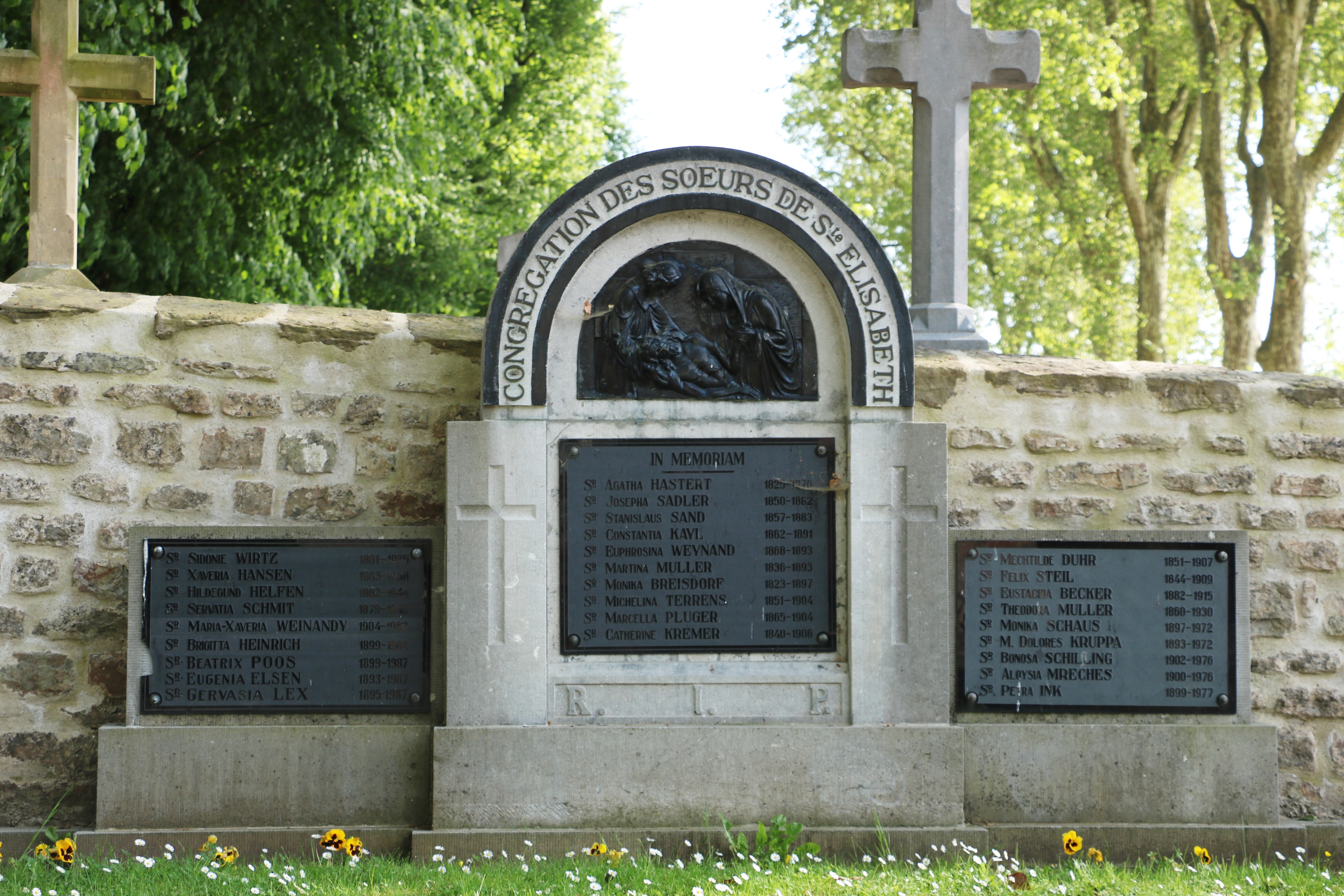Two Nuns’ Stories
Close to the former so-called cimetière des fous, there are two particular tombs, and not by coincidence. First, there is the tomb of the brothers Buffet, who held the position of doctor-directors (médecin-directeurs) of the Hospice Central or the Maison de Santé consecutively, and their wives. Thus, they are buried next to their patients, like “shepherds who loved their herd”, as stated in the epitaph; this reflects the paternalistic mentality of physicians of the time. We will here focus on the second tomb, namely the one dedicated to the nursing sisters of the Congrégation des Sœurs Hospitalières de Sainte Élisabeth who died in Ettelbruck.
Since the beginnings of the Hospice Central in 1855 up until 1989, sisters of the Congrégation des Sœurs Hospitalières de Sainte Élisabeth were attached to the institution in Ettelbruck. Here lie the nursing sisters who died in Ettelbruck; however, not every single nursing sister who worked in Ettelbruck can be found here. Among those resting here, there are, for example, Sister Monique Breisdorf and Sister Agatha Hastert, who were among the first four sisters who arrived in 1855. There is also Sister Théodora Müller, the only Mother Superior of the Elizabethans at Ettelbruck who rests here; she has known the institution as the Maison de Santé at the beginning of the 20th century.

If the sources on the life and the work of the sisters are largely lacking, we can analyse the obituaries (JUSSEAUME). In the case of Sister Aloysia Mreches (1900-1976), we can use an obituary published by “L.M.” in the journal Luxemburger Wort (19.11.1976). She had been working for more than 40 years at Ettelbruck, including almost 35 years as a chief nurse, ever since the Second World War, when she replaced a colleague. In the obituary, she is presented as persevering and strong in her faith. Her job would not have been “for everyone” (“kein Posten für jedermann”), and her task of chief nurse had not been easy: “She was neither squeamish nor sugary” (“Zimperlich und zuckerig war sie nicht”), concludes the author of the obituary. This way, Sister Aloysia was part of those sisters who, during the Battle of the Bulge in 1944, remained, together with other members of the staff, with many patients in the basement of the Maison de Santé.
Almost a hundred years before the death of Sister Aloysia Mreches, the congregation had to grieve the death of another member, who had known a curriculum that was quite different from that of Sister Aloysia: it is Sister Anna von Lassaulx. Once again, an obituary written by François Ratte gives us clues on her life and work. When Clementine entered the congregation around 1850 (thus becoming Sister Anna), her very own sister Hildegard was Mother Superior of the order. In 1858, she replaced Sister Scholastika Biwer in her function of Mother Superior at Ettelbruck. As Mother Superior, she was responsible for the acquisition of food and material through subscription (“par voie d’abonnement”). Sister Anna had used the alms of her family and acquaintances to acquire material for the establishment. According to François Ratte, Sister Anna, who is described as having been very popular with the inhabitants of the Hospice, considered her years at Ettelbruck as “the happiest” (RATTE, p. 16). However, her stay was short, since she succeeded her sister Hildegard as Mother Superior of the whole congregation in 1866.
So here are two stories of sisters, “two nuns’ stories”, very different, but whose common denominator is their stay at the Hospice Central or the Maison de Santé of Ettelbruck.
Several archives and documents have been consulted in order to identify the sisters working in Ettelbruck: Archive of the CHNP: different lists from the second half of the 19th centruy; the dossiers “Relevés du personnel” (1916-1939 and 1940-1964); Archives nationales du Luxembourg: Dossier AE-00237: Culte catholique – Soeurs hospitalières de St. Jean à Luxembourg, devenues plus tard la Congrégation de Ste. Elisabeth: Approbation des statuts; personnification civile, Les Soeurs de Sainte Elisabeth du Grand-Duché de Luxembourg, f. 0133-1034; “État actuel du personnel de la Maison de Santé”, in: Maison de Santé Ettelbruck. 1855-1955, Luxembourg 1955, pp. 59-63.
Documents referring to the acquisition of food and material “par voie d’abonnement” can be found in the Archive of the CHNP, Correspondances 1865 and 1866.
We would also like to thank Dr Yves De Smet for his help.
